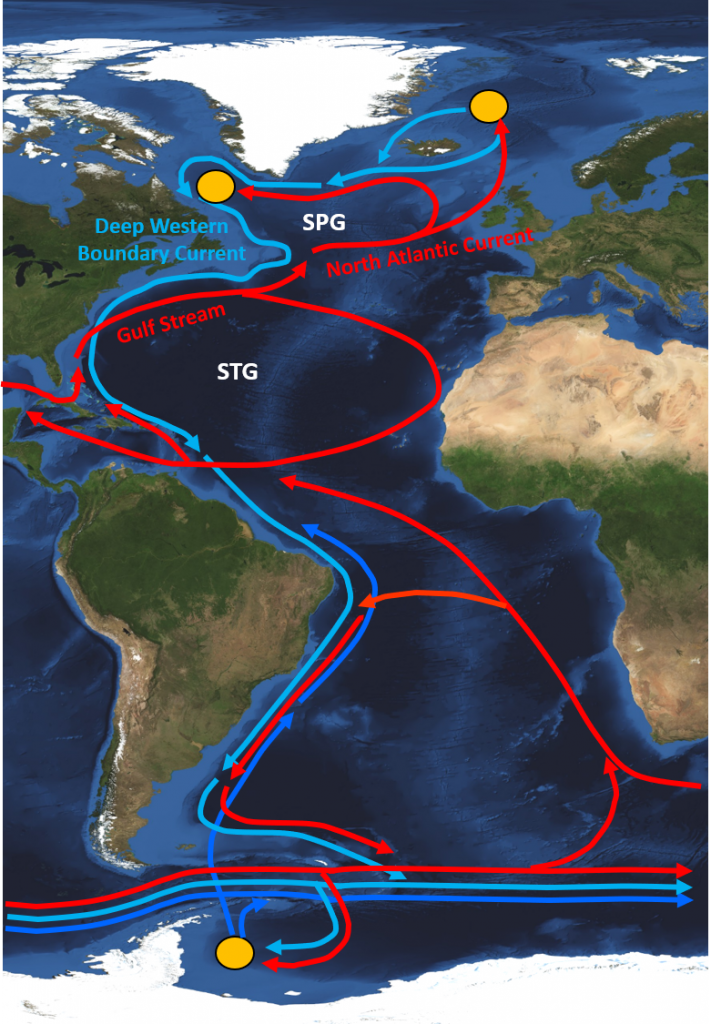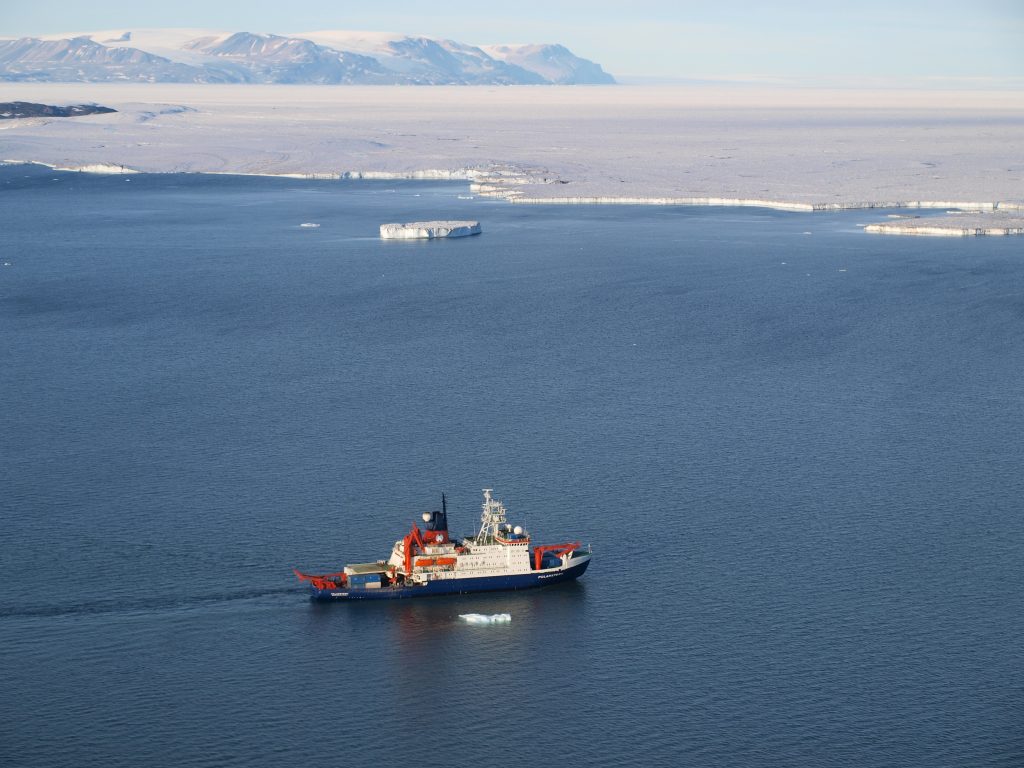What is the AMOC?
The circulation in the Atlantic Ocean is part of a global system of surface and deep currents, the Meridional Overturning Circulation (MOC). This global “conveyor belt” redistributes huge amounts of heat, salt, nutrients, and gases within all oceans. The AMOC transports warm and salty surface water from the tropics northward with the Gulf Stream, continuing its way into the North Atlantic, the Norwegian-Greenland Sea, and the Arctic Ocean as the North Atlantic Current. There, heat is released into the atmosphere, which constitutes the mild climate in Northern Europe. Due to the heat loss, the water density increases, making the water heavier. In the Labrador Sea between Greenland and Canada, and in the Norwegian-Greenland Sea, the strong wintertime heat loss increases the density of the surface water enough to be heavier than the underlying water layers. The surface water sinks down to the deep ocean and returns southward as the cold Deep Western Boundary Current.
What drives the AMOC?
The driving forces of the AMOC are on the one hand differences in temperature and salinity, which induce the sinking of the surface water (deep water formation). This is the so-called thermohaline forcing. On the other hand, winds at the ocean surface are driving the AMOC. To complete the overturning circulation, the heavy water masses of the deep ocean have to mix with the lighter, overlying water masses at another geographical location. This vertical mixing ensures that the overturning circulation can persist in the long term, its driving forces are tides and winds in the high latitudes near Antarctica, as well as in the low latitudes.

The significance of the AMOC
The AMOC is one of the strongest current systems globally: on its way northward, the flow of the Gulf Stream increases from 32 millionen cubic meters per second (1 Mio. m3/s = 1 Sverdrup, Sv) to approximately 150 Sv. This is more than 100 times as much as all rivers of the earth combined. At the junction between the Subtropical Gyre (STG) and the Subpolar Gyre (SPG), approximately 30 Sv of the flow continue into the Subpolar Gyre with the North Atlantic Current, and the rest recirculates within the Subtropical Gyre. In the North Atlantic, the circulation splits up again, and about one third of the flow goes into the Norwegian-Greenland Sea and the Arctic Ocean.
The Deep Western Boundary Current transports about 30 Sv cold deep water along the American continental shelf southward. Part of this deep water recirculates within the North Atlantic, so that about 18 Sv of deep water continue flowing toward the tropics and the South Atlantic.
The maximum heat transport of the Gulf Stream is roughly 1.200.000 gigawatt. The electrical power of an atomic power plant by comparison is typically one gigawatt. Model simulations predict changes in the overturning circulation due to anthropogenic climate change in a time frame of decades to a few centuries, which are mainly caused by changes in the deep water formation in the high northern latitudes. The cooling induced by a weaker overturning circulation could slightly mitigate the trend of global warming in some areas in the Northern hemisphere. However, a weaker overturning circulation could have a multitude of consequences, which entail high risks for society:
- Changes of the Atlantic hurricane activity, of the rainfall in the Sahelian zone, and of the Indian summer monsoon
- Less CO2 from the atmosphere would be transported to the deeper layers of the ocean, with the impact that more CO2 stays in the atmosphere further increasing global warming
- In addition to global sea level rise, a weakened overturning circulation would elevate sea levels in the North Atlantic, resulting in sea levels rising stronger than the global average at coasts bordering the North Atlantic
Observations of the last 20 years from well located current observatories as well as autonomous drifters have shown that the overturning circulation was fairly stable, and fluctuations were in the range of natural variabilty. To detect changes induced by anthropogenic climate change, reliable direct measurements over long periods of time are necessary, embedded within a dense monitoring network. International research efforts continuously improve the data availability, but the time span of observations is not long enough yet to come to definitive conclusions. However, based on the current knowledge, a considerable weakening of the overturning circulation is expected until the end of the 21st century. The actual dimension of the weakening is still uncertain and will greatly depend on the fate of the Greenland ice sheet. More info here

